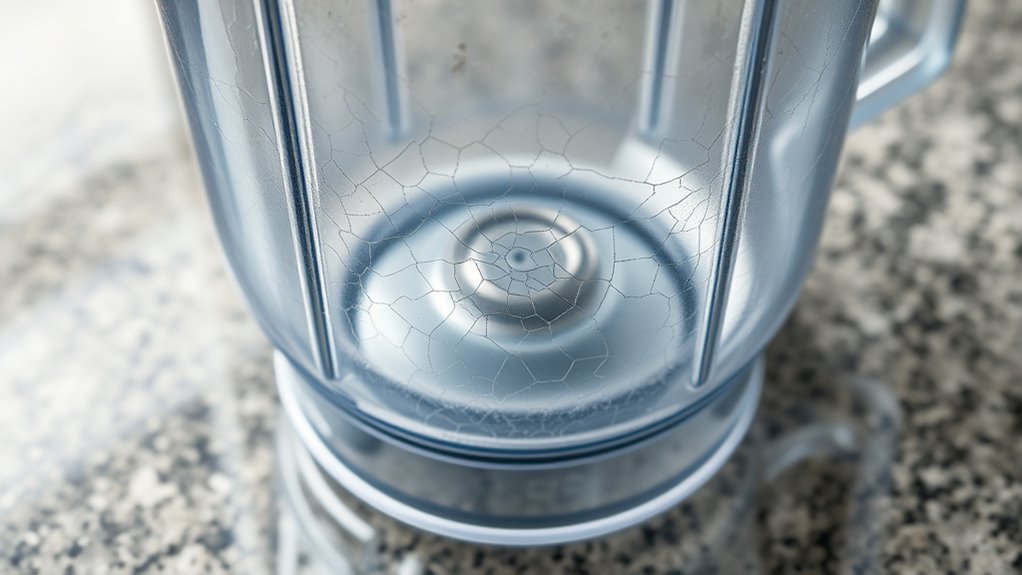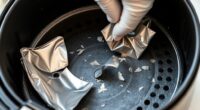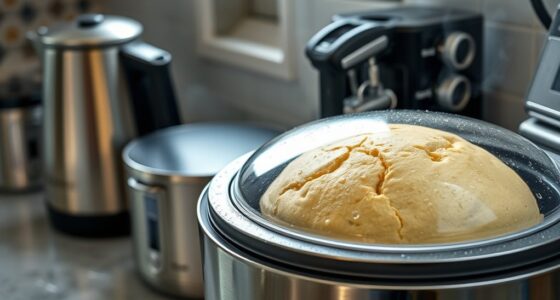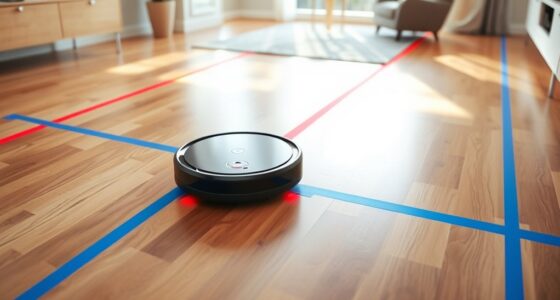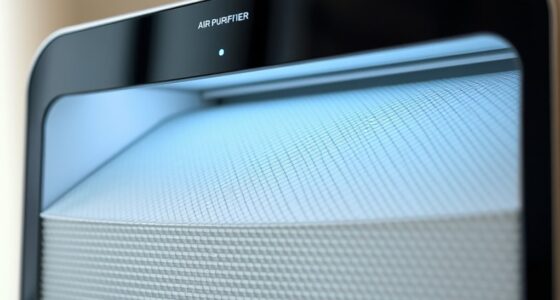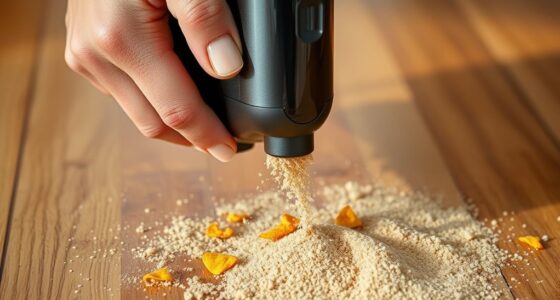To prevent stress fractures and clouding in your blender jar, handle it gently and avoid impacts or forcing the lid on tightly. Use warm water and mild soap for cleaning, and don’t expose the jar to sudden temperature changes—like pouring hot liquids into a cold jar. Choose jars made from durable materials like glass or high-quality plastics. By following these tips, you can extend your jar’s lifespan and keep it in top shape; discover more ways to care for your blender jar as you continue.
Key Takeaways
- Handle the jar gently during assembly, disassembly, and cleaning to prevent impact stress and cracks.
- Avoid exposing the jar to rapid temperature changes, such as pouring hot liquids into cold jars.
- Use the correct speed and stabilization techniques to prevent uneven forces during blending.
- Regularly inspect and replace worn gaskets and lids to ensure a secure, stress-free fit.
- Choose durable materials like tempered glass or impact-resistant plastics to reduce the risk of cracks and clouding.
Recognizing the Causes of Stress Fractures in Blender Jars
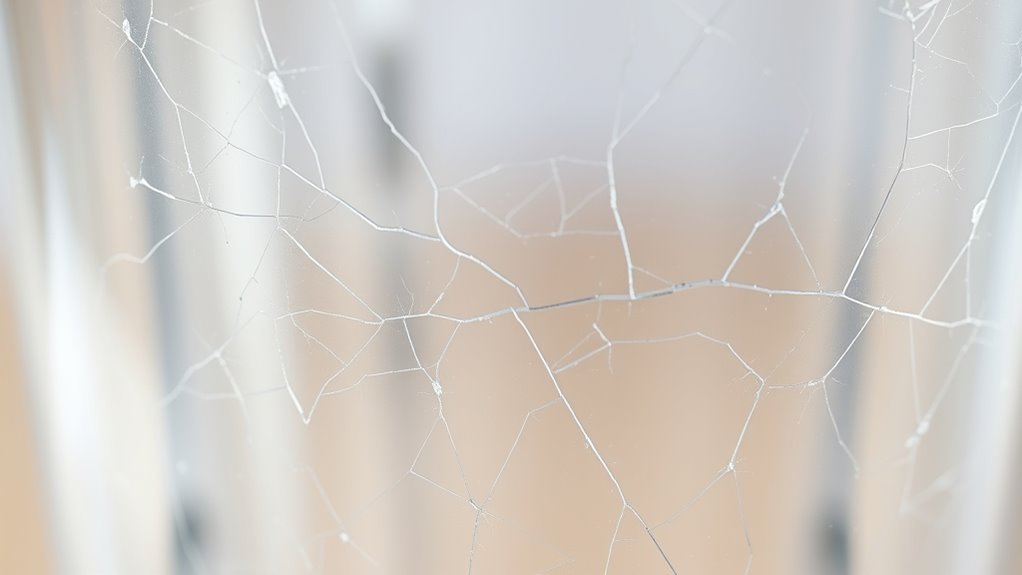
Stress fractures in blender jars often occur when you subject the container to sudden or uneven forces. If you overload your blender or add ingredients too quickly, you put extra strain on the jar’s walls. Using the blender at high speeds without proper stabilization can also cause unnecessary stress. Additionally, forcing the lid on tightly and then blending with force can create uneven pressure, leading to cracks over time. Dropping or banging the jar on countertops introduces impact stress that weakens the material. These sudden or uneven forces cause microscopic cracks that can expand, eventually resulting in visible fractures. Recognizing these behaviors helps you avoid actions that put your blender jar at risk, prolonging its lifespan and maintaining safety during use. Proper handling techniques and understanding the stress distribution within the jar can help prevent these fractures from occurring. Being aware of material fatigue also aids in identifying when a jar may be nearing failure, so you can replace it before a crack develops. Learning about the structural integrity of your blender jar can further help in maintaining its durability over time.
How Temperature Fluctuations Contribute to Clouding and Cracks

Temperature fluctuations can markedly weaken your blender jar over time, leading to clouding and cracks. When you expose your jar to sudden changes—like pouring hot liquids into a cold container or placing a hot jar into cold water—the material expands and contracts rapidly. This stress causes microscopic fractures, which gradually grow into visible cracks. Additionally, repeated temperature swings can damage the internal surface, leading to clouding that reduces clarity and hampers your view of the contents. Over time, these thermal stresses compromise the jar’s structural integrity, making cracks more likely. To minimize damage, avoid abrupt temperature changes, and let your jar gradually adjust to different temperatures. Proper handling of temperature variations helps preserve your blender jar’s clarity and strength longer. Being aware of thermal expansion can help you better understand how temperature fluctuations impact your blender jar’s durability. Understanding material resilience can also guide you in choosing the right jar for varying uses and prevent premature failure. Recognizing the importance of temperature moderation can further extend the lifespan of your blender jar.
Proper Handling and Maintenance to Extend Blender Jar Longevity

To keep your blender jar in good shape and prevent cracks, proper handling and regular maintenance are key. Always avoid sudden impacts or using excessive force when assembling or removing the jar from the blender base. Clean the jar promptly after use with warm water and a mild detergent to prevent residue buildup that can weaken the material over time. Check the rubber gasket and lid regularly for wear and replace them if needed to ensure a proper seal. Avoid using abrasive scrubbers that can scratch the surface, making it more susceptible to cracks. Store the jar in a safe place where it won’t be knocked over or dropped. Regularly inspecting for material fatigue and other cookie categories helps maintain optimal operation and safety. Incorporating automation’s role in business intelligence can also help monitor the condition of your appliances through smart home integrations, ensuring timely maintenance. Additionally, following the manufacturer’s care instructions can significantly reduce the risk of damage. Being aware of material properties can help you choose the right cleaning and handling techniques for your blender jar. With careful handling and consistent upkeep, you’ll considerably extend your blender jar’s lifespan.
Choosing the Right Blender Jar Materials for Durability
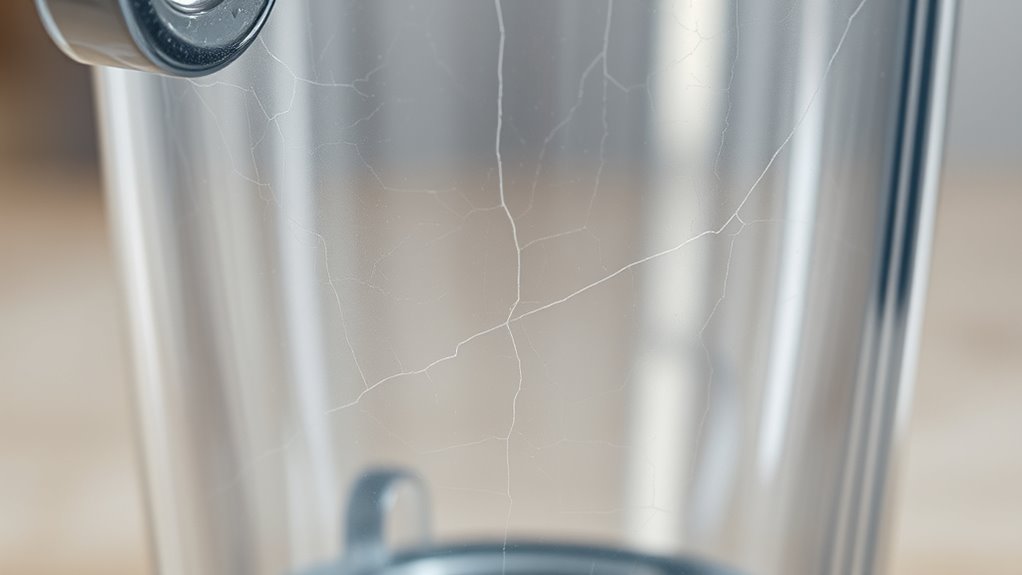
Choosing the right material for your blender jar is essential for durability and long-term use. You want a material that resists cracking, clouding, and staining over time. Glass jars are durable and don’t stain or absorb odors, making them ideal for long-lasting use. They handle high speeds well but can be heavy and prone to breaking if dropped. BPA-free plastics, like Tritan, offer a lightweight alternative that resists clouding and cracking, while being less fragile. BPA-free polycarbonate is durable but may stain or cloud with frequent use. Consider your needs: if you prefer lightweight and shatter-resistant, plastics are your best bet. For longevity and clarity, glass is superior. Additionally, selecting a jar with a robust construction can help prevent cracks and prolong the lifespan of your blender. When choosing a jar, also consider the impact resistance to ensure it withstands daily use and accidental drops, enhancing its durability. Incorporating material strength into your decision can further ensure the jar’s resilience over time, as some materials are engineered with reinforced fibers to improve durability. Moreover, advancements in AI-powered materials testing are contributing to the development of even more durable and resistant blender jars. This will make your blender a reliable kitchen tool. Choosing the right material aligns with your usage habits and ensures your blender remains reliable and durable.
Repairing and Replacing Your Blender Jar When Damage Occurs
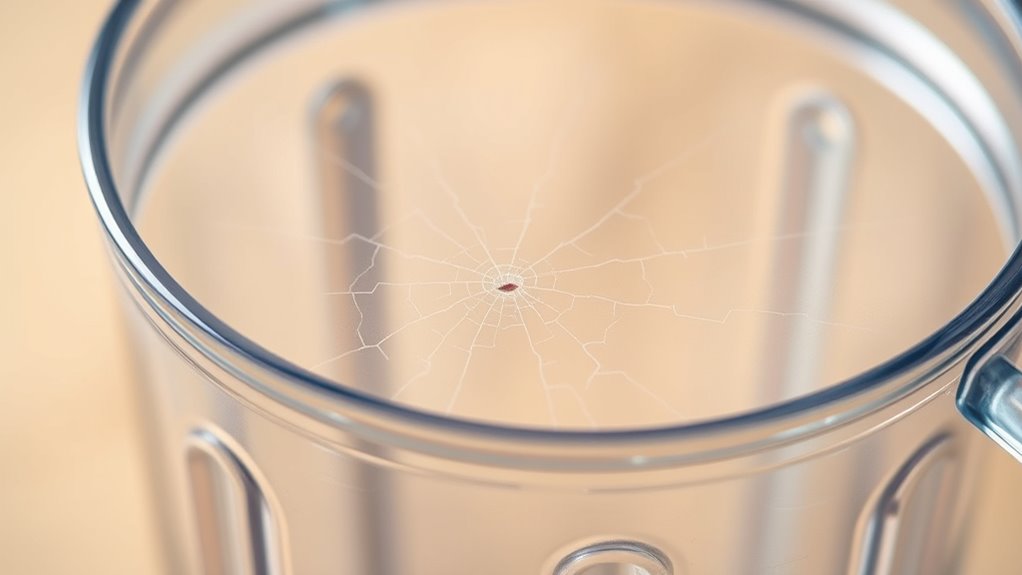
When your blender jar cracks or breaks, acting promptly can save you time and prevent further damage. First, unplug the blender to guarantee safety. If the damage is minor, you might be able to repair it with a food-safe epoxy designed for plastics; clean and dry the area thoroughly before applying. However, for larger cracks or shattered jars, replacement is the safest option. Check your blender’s model number and purchase a compatible replacement jar from the manufacturer or a trusted supplier. Carefully follow the installation instructions to ensure a secure fit. Regularly inspect your new jar for signs of stress or cracking to prolong its lifespan. Staying proactive helps keep your blender functioning safely and efficiently. Additionally, understanding your blender’s material composition can help prevent clouding and stress fractures over time.
Frequently Asked Questions
Can Using Certain Ingredients Increase the Risk of Jar Cracks?
Yes, using certain ingredients can increase the risk of jar cracks. Hard or frozen items, like ice or nuts, put extra stress on the jar, especially if it’s old or already weakened. Acidic ingredients, such as citrus or tomato, can also cause clouding and weaken the material over time. To protect your blender, avoid sudden temperature changes and use ingredients within the recommended guidelines.
Are There Specific Cleaning Methods That Prevent Stress Fractures?
Think of cleaning as a gentle dance with your blender jar. To prevent stress fractures, avoid sudden temperature shifts—don’t pour hot liquids into a cold jar or vice versa. Use soft sponges or brushes, steering clear of abrasive scrubbers that can chip or crack. Instead, opt for warm water and mild soap, giving your jar a tender cleanse. This cautious approach keeps your blender resilient and crack-free.
How Does the Age of the Blender Jar Affect Its Risk of Cracking?
As your blender jar ages, its risk of cracking increases because the material weakens over time and develops microfractures. Continuous use, exposure to temperature changes, and repeated cleaning can accelerate this deterioration. You should regularly inspect your jar for signs of wear, avoid sudden temperature shocks, and replace it when you notice cracks or clouding. Doing so helps prevent unexpected breaks and extends the jar’s lifespan.
Can Improper Assembly Cause Stress Fractures in the Jar?
Yes, improper assembly can cause stress fractures in your blender jar. When you don’t align the lid, base, or blades correctly, you create uneven pressure and tension. This added stress weakens the material over time, increasing the risk of cracks. Always guarantee all parts are securely and properly assembled before use to prevent unnecessary stress on the jar, which helps extend its lifespan and maintain safe operation.
What Are the Signs That a Crack Is About to Develop?
You might notice tiny, almost invisible hairline cracks or a slight cloudiness forming on the jar’s surface. If you see the jar feels unusually hot during use or if there’s a faint odor, these could be signs of stress or internal damage. Pay attention to any changes in sound or texture when blending. Address these signs promptly to prevent full cracks, which could lead to leaks or breakage.
Conclusion
To keep your blender jar crack-free and clear, handle it with care like a fragile glass, avoiding sudden temperature changes and rough treatments. Think of your jar as a delicate vessel—by choosing durable materials and maintaining it properly, you’re protecting your kitchen’s heartbeat. When cracks do appear, act quickly to repair or replace. With mindful care, your blender jar will stand resilient, ready to blend smoothies and soups without the worry of clouding or fractures.
